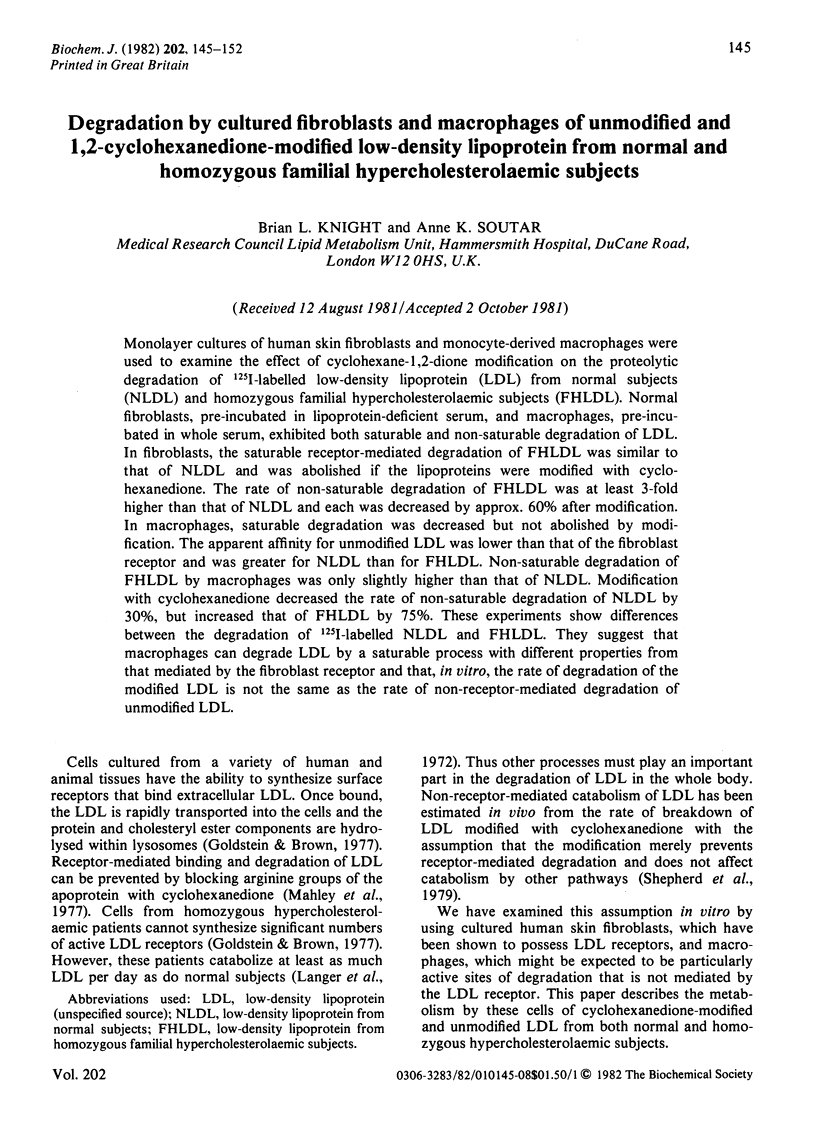Abstract
Monolayer cultures of human skin fibroblasts and monocyte-derived macrophages were used to examine the effect of cyclohexane-1,2-dione modification on the proteolytic degradation of 125I-labelled low-density lipoprotein (LDL) from normal subjects (NLDL) and homozygous familial hypercholesterolaemic subjects (FHLDL). Normal fibroblasts, pre-incubated in lipoprotein-deficient serum, and macrophages, pre-incubated in whole serum, exhibited both saturable and non-saturable degradation of LDL. In fibroblasts, the saturable receptor-mediated degradation of FHLDL was similar to that of NLDL and was abolished if the lipoproteins were modified with cyclohexanedione. The rate of non-saturable degradation of FHLDL was at least 3-fold higher than that of NLDL and each was decreased by approx. 60% after modification. In macrophages, saturable degradation was decreased but not abolished by modification. The apparent affinity for unmodified LDL was lower than that of the fibroblast receptor and was greater for NLDL than for FHLDL. Non-saturable degradation of FHLDL by macrophages was only slightly higher than that of NLDL. Modification with cyclohexanedione decreased the rate of non-saturable degradation of NLDL by 30%, but increased that of FHLDL by 75%. These experiments show differences between the degradation of 125I-labelled NLDL and FHLDL. They suggest that macrophages can degrade LDL by a saturable process with different properties from that mediated by the fibroblast receptor and that, in vitro, the rate of degradation of the modified LDL is not the same as the rate of non-receptor-mediated degradation of unmodified LDL.
Full text
PDF







Selected References
These references are in PubMed. This may not be the complete list of references from this article.
- Bilheimer D. W., Goldstein J. L., Grundy S. M., Brown M. S. Reduction in cholesterol and low density lipoprotein synthesis after portacaval shunt surgery in a patient with homozygous familial hypercholesterolemia. J Clin Invest. 1975 Dec;56(6):1420–1430. doi: 10.1172/JCI108223. [DOI] [PMC free article] [PubMed] [Google Scholar]
- Fogelman A. M., Shechter I., Seager J., Hokom M., Child J. S., Edwards P. A. Malondialdehyde alteration of low density lipoproteins leads to cholesteryl ester accumulation in human monocyte-macrophages. Proc Natl Acad Sci U S A. 1980 Apr;77(4):2214–2218. doi: 10.1073/pnas.77.4.2214. [DOI] [PMC free article] [PubMed] [Google Scholar]
- Goldstein J. L., Basu S. K., Brunschede G. Y., Brown M. S. Release of low density lipoprotein from its cell surface receptor by sulfated glycosaminoglycans. Cell. 1976 Jan;7(1):85–95. doi: 10.1016/0092-8674(76)90258-0. [DOI] [PubMed] [Google Scholar]
- Goldstein J. L., Brown M. S. Binding and degradation of low density lipoproteins by cultured human fibroblasts. Comparison of cells from a normal subject and from a patient with homozygous familial hypercholesterolemia. J Biol Chem. 1974 Aug 25;249(16):5153–5162. [PubMed] [Google Scholar]
- Goldstein J. L., Brown M. S. Familial hypercholesterolemia: identification of a defect in the regulation of 3-hydroxy-3-methylglutaryl coenzyme A reductase activity associated with overproduction of cholesterol. Proc Natl Acad Sci U S A. 1973 Oct;70(10):2804–2808. doi: 10.1073/pnas.70.10.2804. [DOI] [PMC free article] [PubMed] [Google Scholar]
- Goldstein J. L., Brown M. S. The low-density lipoprotein pathway and its relation to atherosclerosis. Annu Rev Biochem. 1977;46:897–930. doi: 10.1146/annurev.bi.46.070177.004341. [DOI] [PubMed] [Google Scholar]
- Goldstein J. L., Brunschede G. Y., Brown M. S. Inhibition of proteolytic degradation of low density lipoprotein in human fibroblasts by chloroquine, concanavalin A, and Triton WR 1339. J Biol Chem. 1975 Oct 10;250(19):7854–7862. [PubMed] [Google Scholar]
- Jadhav A. V., Thompson G. R. Reversible abnormalities of low density lipoprotein composition in familial hypercholesterolaemia. Eur J Clin Invest. 1979 Feb;9(1):63–67. doi: 10.1111/j.1365-2362.1979.tb01668.x. [DOI] [PubMed] [Google Scholar]
- Johnson W. D., Jr, Mei B., Cohn Z. A. The separation, long-term cultivation, and maturation of the human monocyte. J Exp Med. 1977 Dec 1;146(6):1613–1626. doi: 10.1084/jem.146.6.1613. [DOI] [PMC free article] [PubMed] [Google Scholar]
- LOWRY O. H., ROSEBROUGH N. J., FARR A. L., RANDALL R. J. Protein measurement with the Folin phenol reagent. J Biol Chem. 1951 Nov;193(1):265–275. [PubMed] [Google Scholar]
- Langer T., Strober W., Levy R. I. The metabolism of low density lipoprotein in familial type II hyperlipoproteinemia. J Clin Invest. 1972 Jun;51(6):1528–1536. doi: 10.1172/JCI106949. [DOI] [PMC free article] [PubMed] [Google Scholar]
- Mahley R. W., Innerarity T. L., Pitas R. E., Weisgraber K. H., Brown J. H., Gross E. Inhibition of lipoprotein binding to cell surface receptors of fibroblasts following selective modification of arginyl residues in arginine-rich and B apoproteins. J Biol Chem. 1977 Oct 25;252(20):7279–7287. [PubMed] [Google Scholar]
- McFARLANE A. S. Efficient trace-labelling of proteins with iodine. Nature. 1958 Jul 5;182(4627):53–53. doi: 10.1038/182053a0. [DOI] [PubMed] [Google Scholar]
- Miller N. E., Weinstein D. B., Steinberg D. Uptake and degradation of high density lipoprotein: comparison of fibroblasts from normal subjects and from homozygous familial hypercholesterolemic subjects. J Lipid Res. 1978 Jul;19(5):644–653. [PubMed] [Google Scholar]
- Shepherd J., Bicker S., Lorimer A. R., Packard C. J. Receptor-mediated low density lipoprotein catabolism in man. J Lipid Res. 1979 Nov;20(8):999–1006. [PubMed] [Google Scholar]
- Thompson G. R., Lowenthal R., Myant N. B. Plasma exchange in the management of homozygous familial hypercholesterolaemia. Lancet. 1975 May 31;1(7918):1208–1211. doi: 10.1016/s0140-6736(75)92193-5. [DOI] [PubMed] [Google Scholar]
- Traber M. G., Kayden H. J. Low density lipoprotein receptor activity in human monocyte-derived macrophages and its relation to atheromatous lesions. Proc Natl Acad Sci U S A. 1980 Sep;77(9):5466–5470. doi: 10.1073/pnas.77.9.5466. [DOI] [PMC free article] [PubMed] [Google Scholar]


